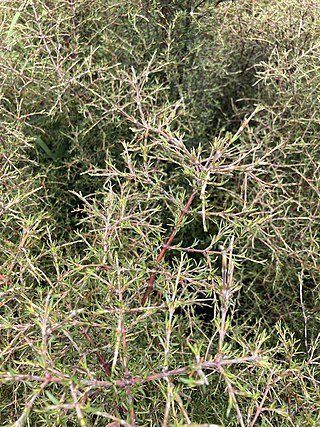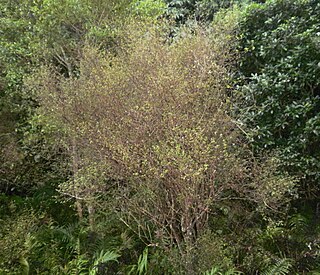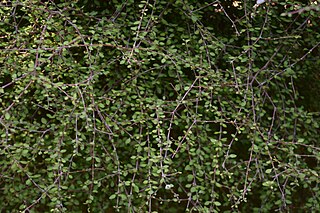
Coprosma robusta, commonly known as karamu, is a flowering plant in the family Rubiaceae that is endemic to New Zealand. It can survive in many climates, but is most commonly found in coastal areas, lowland forests, or shrublands. Karamu can grow to be around 6 meters tall, and grow leaves up to 12 centimeters long. Karamu is used for a variety of purposes in human culture. The fruit that karamu produces can be eaten, and the shoots of karamu are sometimes used for medical purposes.

Byrsonima crassifolia is a species of flowering plant in the family Malpighiaceae, native to tropical America. Common names used in English include nance, maricao cimun, craboo, and golden spoon. In Jamaica it is called hogberry.

Coprosma is a genus of flowering plants in the family Rubiaceae. It is found in New Zealand, Hawaiian Islands, Borneo, Java, New Guinea, islands of the Pacific Ocean to Australia and the Juan Fernández Islands.

Scaevola crassifolia is a shrub in the family Goodeniaceae, native to Western Australia and South Australia. Common names include cushion fanflower, thick-leaved fanflower and thick-leaved scaevola. It grows up to 1.5 metres high and 3 metres wide and produces white, blue or pale purple flowers from July to February in its native range.

Coprosma rhamnoides is an endemic shrub in New Zealand. It forms a small shrub up to 2 m tall. The leaves are very small, simple and variable in shape. The inconspicuous flowers are unisexual and believed to be wind pollinated. It is widespread in occurrence and can be the dominant small leaved divaricating shrub in some locations

Coprosma rugosa, also known as the needle-leaved mountain coprosma, is a shrub in the coffee family, Rubiaceae, that is native to New Zealand.

Coprosma propinqua is a New Zealand plant of the genus Coprosma in the family Rubiaceae. Its Māori name is mingimingi, a name which is also applied to closely related species such as C. dumosa, C. rhamnoides, C. virescens and C. crassifolia. It is a small-leaved shrub or tree which grows 3 to 6 metres high. It has divaricating branches, and is common in swampy forest, in scrub, along stream banks and in stony places. It has a wide distribution, ranging from Mangonui in the North Island as far south as Stewart Island. It grows from sea level to 460 metres.

Coprosma autumnalis or C. grandifolia according to earlier Colenso authority, is a native forest shrub of New Zealand. Its widespread in both the North and South Islands, and has the largest leaves of any New Zealand coprosma.

Coprosma rotundifolia is a native forest shrub of New Zealand found on the North, South, and Stewart Islands.

Coprosma tenuicaulis, commonly called swamp coprosma is a native shrub of New Zealand. As its name suggests C. tenuicaulis is found in wet, boggy soil in and around swamp or lake areas.

Coprosma rigida, is a shrub that is native to New Zealand. C. rigida grows to 4 metres high and is found in shady, damp forest areas with poor drainage. Typical habitat for it is on river banks and forest edges.

Coprosma macrocarpa, also known as large-seeded coprosma and coastal karamu, is a shrub native to New Zealand. It has large thick leaves and large bright red/orange berries. Macrocarpa means "large fruit".

Coprosma acutifolia, is a shrub that is native to New Zealand, found only on Raoul Island. C. acutifolia can grow up to 12 metres tall in wet or dry forest, becoming a sub-canopy tree at lower altitudes and a canopy species along ridgelines.

Coprosma waima, is a nationally endangered shrub of New Zealand. In the wild it only occurs in the Waima forest in the Northland Region.

Coprosma ciliata, is a shrub in the family Rubiaceae that is endemic to New Zealand. C. ciliata is found in the South Island from Lake Brunner southwards into Fiordland mostly west of the Southern Alps. The species prefers lowland forest where it often occurs beside streams, swamps and lakes.

Coprosma linariifolia, commonly called mikimiki or yellow wood, is a shrub or small tree that is native to New Zealand. C. linariifolia is found in lowland to montane forest and scrub from the central North Island to the bottom of the South Island.

Coprosma wallii, is a rare shrub found in New Zealand.

Coprosma rubra is a shrub native to New Zealand.

Coprosma hirtella is a shrub in the family Rubiaceae. It is endemic to south-eastern Australia. It grows to about 2 metres high and has leaves that are between 15 and 50 mm long and 10 to 25 mm wide. Plants have male and female flower clusters that appear between August and April. These are followed by orange to reddish fruits that are 7 to 8 mm in diameter.

Coprosma virescens is an endemic New Zealand plant in the genus Coprosma of the family Rubiaceae. Its Māori name is mingimingi, a name which is also applied to closely related species such as C. dumosa, C. rhamnoides, C. propinqua and C. crassifolia. It is a small-leaved shrub or tree which grows 2 to 3 metres high. It has very slender, more or less glabrous divaricating branches. The small leaves are petiolate with petioles from 2mm to 5mm long. The leaves narrow suddenly at the petiole and may be up to 9 millimetres (0.35 in) long and 6 millimetres (0.24 in) wide with wavy margins or a few blunt teeth throughout South Island in lower montane forest and scrubland. The apetalous male flowers occur in axillary clusters of one to two on very short branches. Female flowers are found on their own at the ends of short branchlets.



















